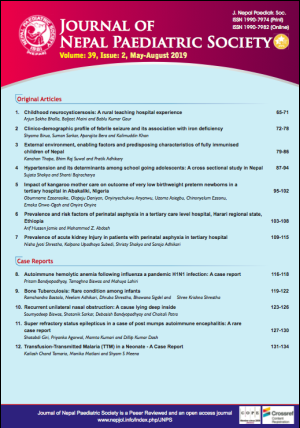Prevalence and Risk Factors of Perinatal Asphyxia in a Tertiary Care Level Hospital, Harari Regional State, Ethiopia
DOI:
https://doi.org/10.3126/jnps.v39i2.26408Keywords:
Harari, newborn, prevalence, preinatal asphyxiaAbstract
Introduction: Globally birth asphyxia continues to present a major clinical problem. It is one of the common and leading causes of perinatal and neonatal mortality and morbidity especially in developing countries.
Methods: A cross-sectional study was conducted among newborns in a tertiary level hospital, Ethiopia from February to July 2019. Systematic random sampling technique was used to select the study subjects. Multivariate logistic regression analysis was used to identify factors associated with the perinatal asphyxia among newborns.
Results: Of the newborns, 32% had perinatal asphyxia and factors significantly associated were anaemia during pregnancy (adjusted OR = 2.99, 95% CI: 1.07 – 8.35), chronic hypertension (adjusted OR = 4.89, 95% CI: 1.16 – 20.72) and low birth weight newborns (adjusted OR = 3.31, 95% CI: 1.308 – 8.37).
Conclusions: Maternal anaemia during pregnancy, chronic hypertension and low birth weight were significantly associated with perinatal asphyxia. Therefore, early screening and appropriate intervention during pregnancy and intra-partum might reduce perinatal asphyxia among newborns.
Downloads
Downloads
Published
How to Cite
Issue
Section
License
Authors who publish with this journal agree to the following terms:
Authors retain copyright and grant the journal right of first publication with the work simultaneously licensed under a Creative Commons Attribution License that allows others to share the work with an acknowledgement of the work's authorship and initial publication in this journal.
Authors are able to enter into separate, additional contractual arrangements for the non-exclusive distribution of the journal's published version of the work (e.g., post it to an institutional repository or publish it in a book), with an acknowledgement of its initial publication in this journal.
Authors are permitted and encouraged to post their work online (e.g., in institutional repositories or on their website) prior to and during the submission process, as it can lead to productive exchanges, as well as earlier and greater citation of published work (See The Effect of Open Access).



